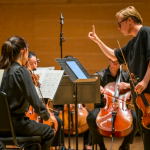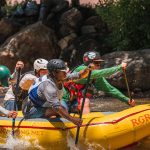Lo-Fidelity: The landscape art-citecture of Herbert Bayer

Austin Colbert/The Aspen Times
My succinct interpretation of Herbert Bayer’s local body of work is not one you’ve heard before. I categorize Bayer as the very first, inadvertent designer of urban skate parks and BMX terrain parks, and lucky for us, he built them right here in Aspen. As kids, we immediately identified that irreverent functionality and exploited the vulnerabilities of his works. Herbert Bayer’s landscape “art-citecture,” as I call it, afforded us local hoodlums hours upon hours of highly (literally and figuratively) unsupervised play.
I went and checked out the latest “Sculpting the Environment” exhibit at the Resnick Center for Herbert Bayer Studies and those memories of playing upon his works came flooding over me like a vigorous spring runoff. Big thanks to Lynda Resnick for her generosity and vision in bringing Bayer’s important pieces to the forefront where they belong. It’s free. Go check it out. They have a cool gift shop, too.
People often speak of the Bayer-esque ethos in terms of Mind, Body, Spirit, as the “Aspen Idea.” As local youth, we had ideas and schemes of our own: to gleefully ride our skateboards and BMX bikes all over the playground he had unintentionally created for us. While wearing OP shorts and Vans tennis shoes, we tagged his art by skidding rear tires of our bicycles and neon Kryptonite wheels of our skateboards across the concrete. There’s no other way to put it: We were vandals.
Last Friday, I had the pleasure of meeting Bayer’s granddaughter, artist and Bayer-phile extraordinaire, Koko Bayer. I asked her if she was aware of this phenomenon of his landscape art being used in a more, shall we say, physical way.
“Herbert’s Articulated Wall sculpture in Denver is one of the 10 holy grails of urban mountain climbing,” Koko told me. “How artists plan works and then (how) people actually use them is a completely different thing. I think Herbert really loved that people found other uses for his art.”
I’m not sure Herbert would of necessarily approved of our skateboarding on the music tent roof, skateboarding and jumping our BMX bikes off of the music tent stage and down the isles, and skateboarding in the Aspen Meadows swimming pool each spring and fall. The surfaces undoubtedly need to be ridded of our skid marks and repainted after all the hooliganism. Does anyone remember that small, pointed tent they used to put up next to the Music Tent for the IDCA (design Conference)? We used to climb all over that at night, too.
I attended the Aspen Institute’s 75th celebration last Saturday in the ongoing lost-and-found search for my own mind, body, and spirit. I’m a big fan of the Aspen Institute. I’ve spent years of my life there. I still go there as a touchstone to look for answers to questions without replies. I received my very first paycheck from the Aspen Institute at age 15, under the watchful eye of the mighty King Woodward, who I learned from Koko oversaw the construction of Anderson (terrain) Park. King had chased us off of the roof of the music tent, and away from the Institute grounds many, many times. King becoming my boss was an important full-circle learning moment.
Koko and I both wondered how in the world the park was seeded and irrigated back then. As a lawncare maintenance professional, I often wonder what it would be like to mow the mounds and grounds of Anderson Park. Those opposing mounds and divots have to be a challenge to mow — not to mention the grass donut in the pond. When I first saw the sunken grass ring sculpture over by the Aspen Meadows, I envisioned myself zooming around in circles on my BMX bike like James Kahn in the movie “Rollerball.”
During my interview with Koko, I asked the question that every dime-store psychedelic journeyman wonders while gazing upon Bayer’s mind-altering art: Did he ever do hallucinogens? Koko pointed out that the eras didn’t line up, and we both agreed that drugs probably would’ve been a hindrance to his manic creativity more that anything. Regardless, as youth gone wild, we picked up the slack for him and did the heavy psychedelic lifting.
During the “Sculpting the Environment” lecture at Paepcke auditorium, Koko spoke of the epiphany she had about being shaped by all of the Bayer artwork and sculptures in her house growing up. Her astute observation led me to the same conclusion: I had also been deeply influenced by his artwork, landscape art-chitecture, sculptures, and (my favorite) tapestries. As a kid, I was magnetically drawn to his work like a mosquitos to a bug zapper light. His work is in my DNA and continues to influence me today. From first playing on the landscapes, then working around the architecture, and now ultimately gazing upon his sculpture and art, I’ve come full circle, from a vandal to a fan.
Old habits die hard. On my way to the Aspen Institute 75th celebration, I rode my e-bike through Anderson Park. Just before the bridge, there were some workers prepping for an event and had the path blocked. Like a dog chasing a squirrel, I instinctually rode up and over one of the mounds just like I was that devious kid again. The employee gave me the exact same look of disapproval I’ve become accustomed to over my lifetime.
Needless to say, our childhood trespasses and escapades on Bayer’s landscapes were unwelcome and generally frowned upon. Architectural, philosophical, and athletic purists may scoff at our shenanigans, but I wear them as a badge of honor and will take them to my grave at the Aspen Grove Cemetery.
Contact Lorenzo via suityourself@sopris.net.
Aspen area included in ‘release zone’ for wolverine reintroduction
The Aspen area has been included in one of three general release zones for the reintroduction of wolverines into the state, according to preliminary information from Colorado Parks and Wildlife’s developing plan.









